Experimental results with various protocols
Here, we show some of our results that we achieved by running the simulator with various different parameters. But first, let’s discover the tools that we prepared for you to help your experimentation with our ethp2psim.
Resources for running experiments
If you want to compare how well the adversary can deanonymize message sources (or originators) for different message passing protocols (e.g., ethp2psim.protocols.BroadcastProtocol, ethp2psim.protocols.DandelionProtocol, ethp2psim.protocols.DandelionPlusPlusProtocol, ethp2psim.protocols.OnionRoutingProtocol) then we recommend you to use our Bash script. that have three parameters:
The number of independent trials to use to gain insights. The mean deanonymization performance of the adversary will be reported with respect to these trials. Basically, the number of trials represents the number of different network and adversary settings in the experiment. In each setting, we simulate multiple messages (approximately 10% of the P2P nodes) over a fixed network and a fixed set of adversarial nodes.
The size of the P2P
network.Networkto simulate. If you set 0, then the script will load thedata.GoerliTestnet.Specify a centrality measure (e.g., degree, pagerank or betweenness) to measure the
adversary.Adversaryperformance when it controls the most central nodes of the network.
For example, run the following commands in parallel to save some execution time:
bash run_experiments.sh 10 1000
bash run_experiments.sh 10 0
bash run_experiments.sh 10 1000 degree
bash run_experiments.sh 10 0 degree
This way you will be able to compare results based on 10 trials for a random regular graph with 1000 nodes and 50 degree and the underlying graph of the Goerli (Goerli) testnet. Adversary performance will be evaluated for both highest degree and uniform random node sampling settings.
A few interesting results
In the following, we include some fascinating simulation results produced by ethp2psim. You can create similar and more advanced measurements using this tool. The following examples might serve as some inspiration to what you can build using this tool. Let’s analyze some of the privacy-enhancing routing algorithms in various networks and adversarial settings!
A discussion on performance metrics
First, let’s start with a simple experiment where we compare the deanonymization power of the adversary when it uses the first-reach or the first-sent heuristics to determine the originator for each message. These estimator strategies are used to guess the first node that broadcasted a given message based on the observations of all adversarial nodes. In short, an adversary using the first-reach heuristic predicts a node to be the first broadcaster if it is the first node that it heard the message from. On the other hand, using the channel latency information of adjacent channels, a first-sent estimator tries to identify the neighbor that first sent the message to any of the adversarial nodes. Naturally, the two predictions might not coincide as the triangle inequality does not necessarily hold for P2P network latency.
In this experiment, we use a random regular graph with 1000 nodes and 50 degree to compare the two heuristics against multiple protocols. Not surprisingly, our results in the first Figure show that the adversary with the first-sent estimator performs significantly better. However, we highlight that only the hit ratio, inverse rank and NDCG can reflect this behavior where ground truth information about message sources is compiled into the evaluation.

Unfortunately, entropy does not depend on the ground-truth. It only measures the uncertainty of the predicted distribution, but not its closeness to the ground-truth. Nevertheless, the entropy for Dandelion++ is higher than for Dandelion in the next Figure. The prediction entropy for broadcast to all and our Onion Routing based protocol is zero as the predicted distribution only contains the most likely candidate. A possible future work could include additional less-likely candidates as well in the prediction distribution, this way better reflecting the knowledge of the adversary.
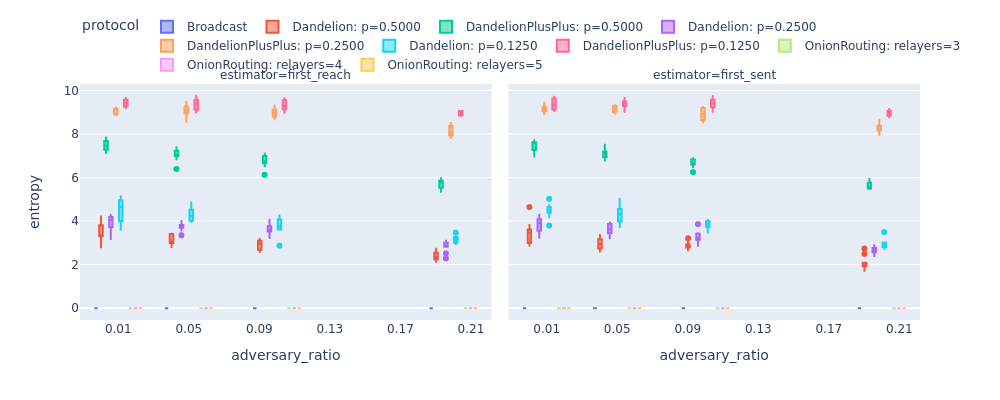
In the first Figure, it is interesting to see how Dandelion can confuse the adversary compared to simple broadcasting in terms of hit ratio (e.g., first-sent performance drops from 0.5 to 0.3 in case of 10% adversarial nodes) which might indicate that it is overly restrictive, as it doesn’t contain information about much of the predicted distribution. Instead, our recommendation is to use inverse rank or NDCG for evaluation. These metrics can better reflect that despite the higher uncertainty introduced by Dandelion(++) the adversary can still make a good educated guess in knowledge of the current anonymity graph (i.e., line-graph for Dandelion). For example, in the first Figure, it is quite shocking to see the change in inverse rank from 0.5 to 0.4, which means that on average Dandelion improves only half a rank for the predicted message source, in case of 10% adversarial nodes.
A possible solution to the problem could be ethp2psim.protocols.OnionRoutingProtocol (our work ) that uses enrypted messages in the anonymity phase to hide the originator from the adversary. Indeed, our results show that deanonymization performance remains low even for high adversarial node ratios.
Comparing different network topologies
In the Figure below, we observe how different graph topologies, such as a random regular graph and a scale-free graph (Goerli testnet’s topology), affect the adversary’s deanonymization power measured by various different metrics (e.g., hit ratio, inverse rank, NDCG). The deanonymization performance is displayed with respect to the ratio of adversarial nodes (see the x-axis) in the P2P network.
Here, we make four main observations related to privacy:
The achieved privacy is quite brittle in case of 0.2 adversary ratio: 0.5 inverse_rank for Dandelion with 0.5 broadcast probability means that the adversary outputs a vector of candidates and on average the true originator is put to the 2nd place.
Dandelion(++) with the least broadcasting probability (p=0.125) provides the highest privacy among the considered Dandelion(++)-style protocols.
The results are promising for our Onion Routing based protocol where the efficiency of the adversary is less affected by the ratio of adversarial nodes in the P2P network.
In general the Goerli testnet exhibits more privacy across all metrics.
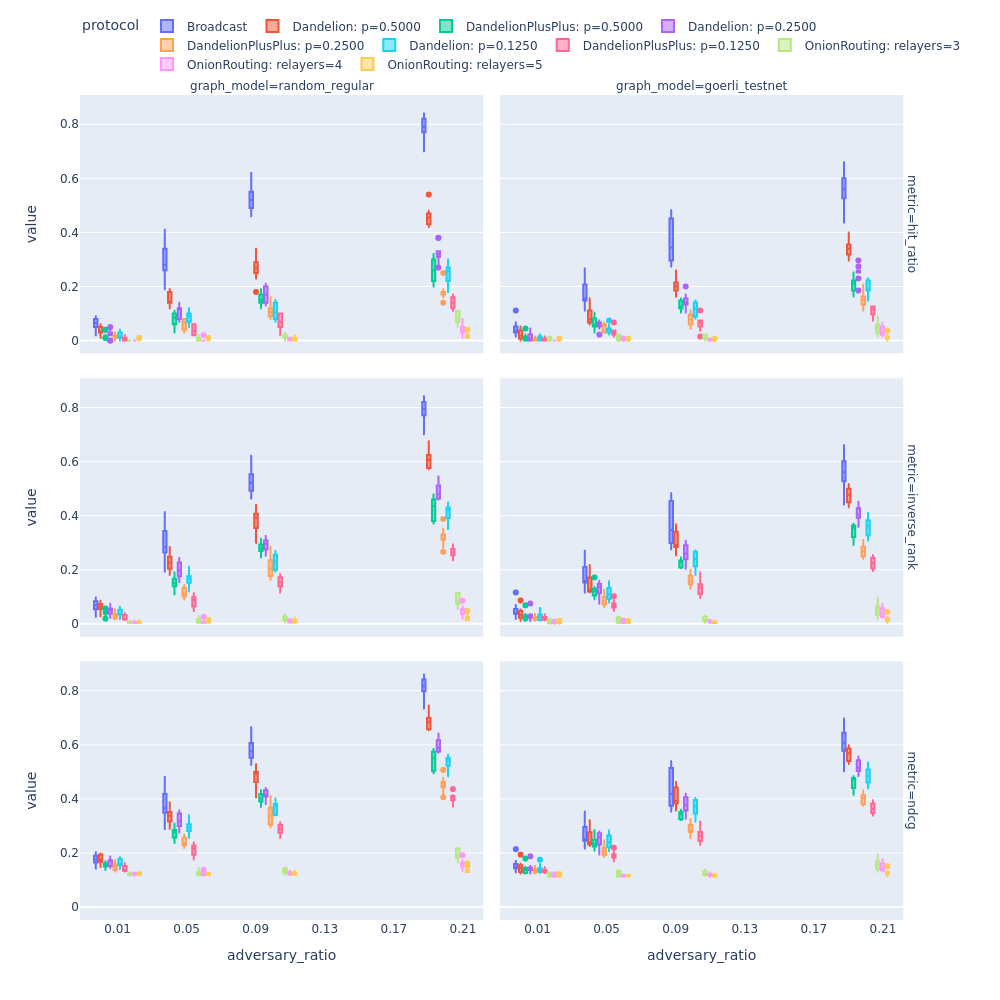
Broadcast settings
Next, observe the significant change in the results when a message is propagated to all neighbors, instead a random square root of them, during the broadcast phase. It is quite shocking that an adversary controling 10% of all nodes can be almost sure about the identity of the message source in case of simple protocols.BroadcastProtocol. Clearly, Dandelion(++) can significantly decrease the deanonymization performance of the adversary but it has a high price in terms of robustness detailed in the next section.
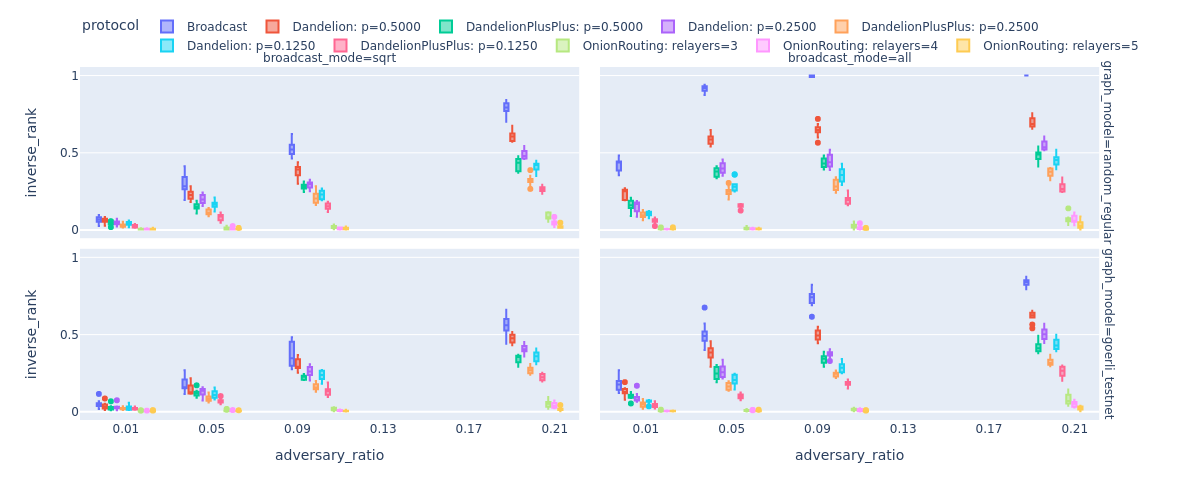
Robustness for active and passive adversary
In our next experiment, we consider two types of adversaries. A passive adversary that follows the protocol and only logs the timestamp information when its nodes encounter messages. We also implemented an active adversary that does not forward messages at all. In the next Figure, we show that this is especially problematic for Dandelion(++). Imagine that an active adversary sits in the stem (anonymity) phase of Dandelion(++). Basically, if a message encounters an adversarial node on the line graph then it will be never broadcasted. The more and more adversaries censor messages the larger the portion of messages that are not heard by nodes in the P2P network. This is even more concerning, when the high-degree nodes are compromised (e.g., adversary_centrality=’degree’). Note that the random regular graph is more robust against (active) adversaries.
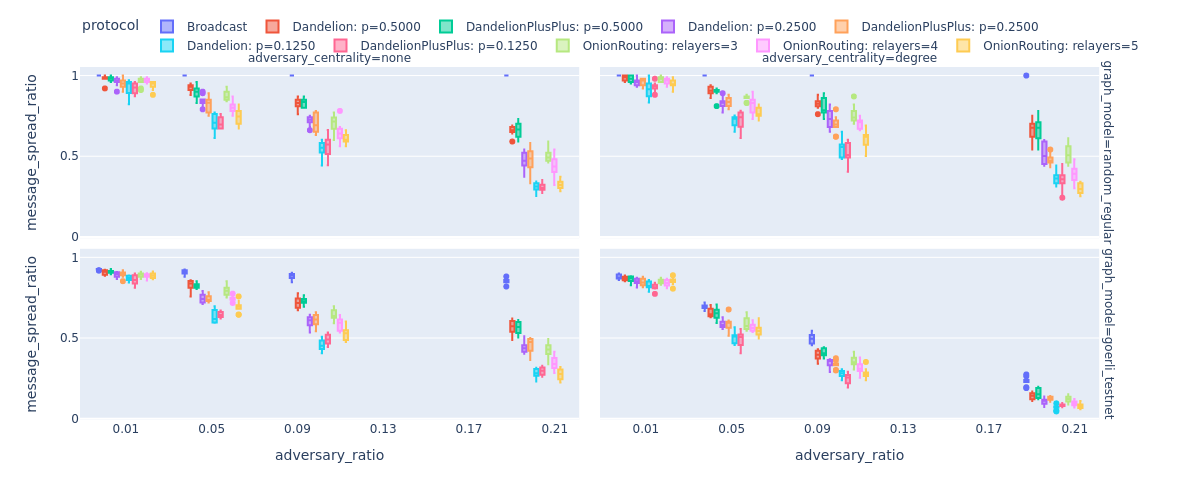
In the next Figure, once again, we see the low levels of privacy (measured in inverse rank in this figure) provided by various privacy-enhanced routing algorithms. It is easy to see that in our setting active and passive adversaries have the same power to deanonymize messsage. Deanonymization results are slightly better for the Goerli testnet’s topology, i.e., the adversary is less powerful on a scale-free graph. In our experiments, the random regular graph has a higher edge density, hence, the adversary can make a more informed guess about the originator of the messages.
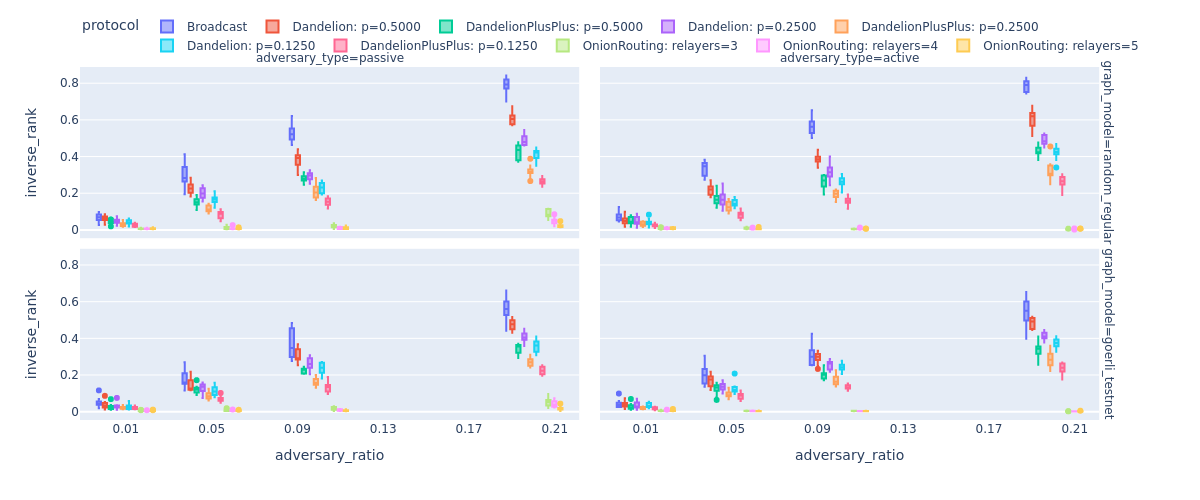
How to visualize results?
In our Github repository, we published the notebook that we used to visualize the results. We hope that it also helps you to visualize your finding.